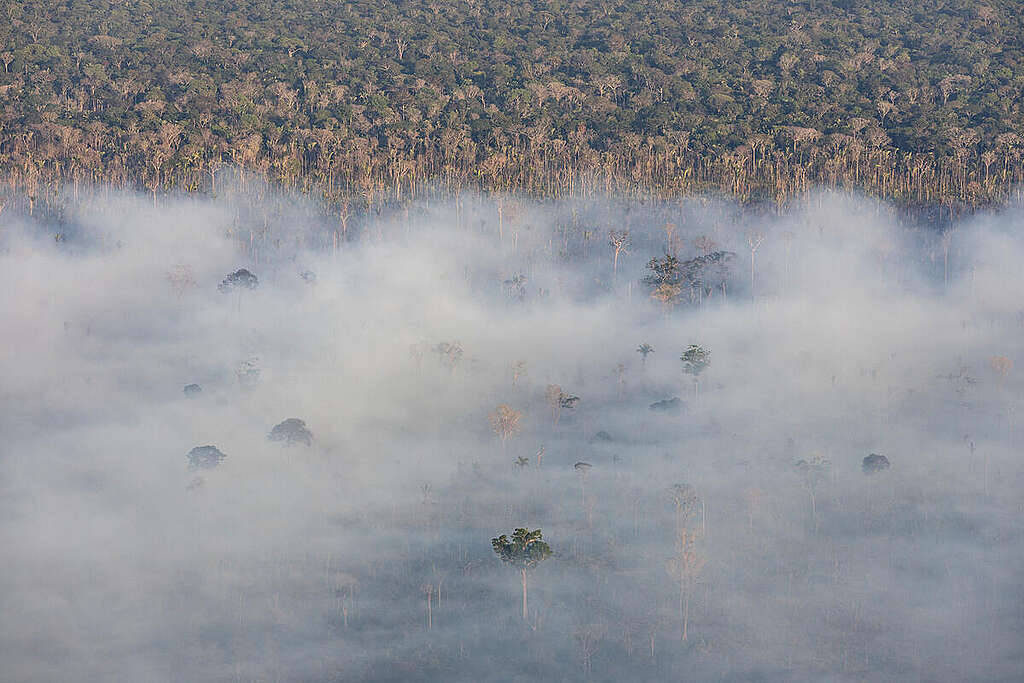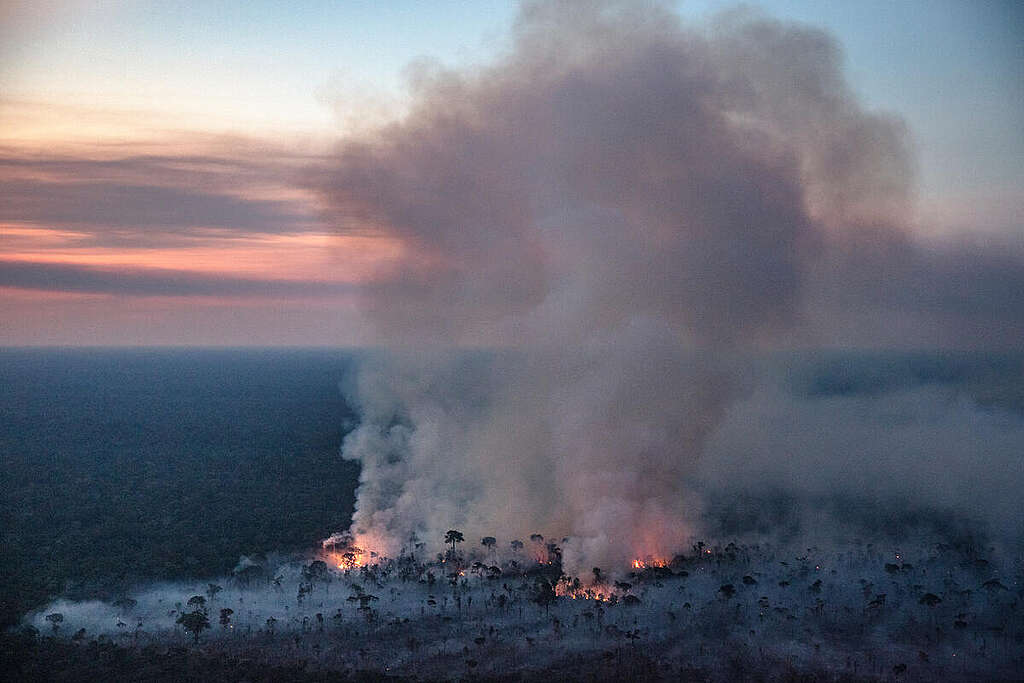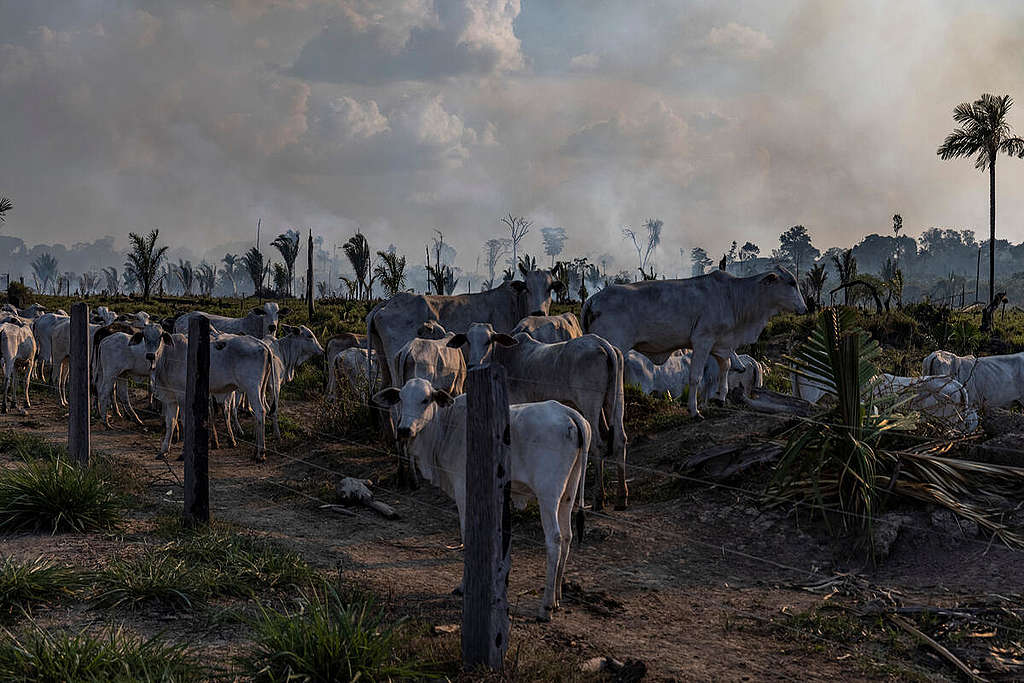It is 2023 and the world is witnessing in horror historic record high temperatures. The planet is on fire in nature’s response to our inaction against climate change. But in the Amazon, the fires that burn forests into ashes have a slightly different cause — greed.
The infinite exploitation of finite natural resources is the root of the problem. This model generates profit for a small group of people while dragging society into dangerous circumstances. It seems that we’ve played with fire so much that we ourselves are very close to getting burned.

Greenpeace Brazil flew over areas with deforestation and fire alerts in the Amazon between August 2nd and 4th, 2023, especially in the states of Amazonas, Rondônia, and Acre, to register and show the destruction taking place in the forest.
Amazon Rainforest Day is annually Sept. 5, and it inspires me to celebrate the exuberance of this biome’s rivers, trees, and people. But we also need to pause, reflect upon the current circumstances and consider how far we are willing to go for the preservation of the forests and so many other natural environments around the world.
Amazon, the green giant
The Amazon Basin covers an area of 6.7 million km², spread across nine South American countries: Brazil, Bolivia, Colombia, Ecuador, Guyana, French Guiana, Peru, Suriname, and Venezuela. Most of it is in Brazil, which holds 60% of this massive forest and the majority of the population living in the region, about 28 million people out of a total of 38 million in the Pan-Amazon.
The Amazon is as vast as it is diverse. Within its ecosystems such as forests, mangroves, fields, and mountains, 10% of Earth’s biodiversity thrives. In addition to storing 150 to 200 billion tons of CO2eq (carbon dioxide equivalent) in its soil and trees, the forest also releases 20 trillion liters of water into the atmosphere daily, functioning as a global air conditioner.
But despite the magnitude of these numbers, the forest is dangerously under threat. Science warns of a point of no return for much of the Amazon, the so-called tipping point, after which, species and a variety of benefits and environmental services provided by the Amazon will be lost. Initial estimates on the matter calculated that this point could be reached when 40% of the forest has been lost to deforestation. However, more recent studies that considered the “negative synergy” between deforestation, climate change, and widespread use of fire have recalibrated this estimate, and today it is believed that if 20 to 25% of the forest is lost, it is game over for us.

Greenpeace Brazil flew over areas with deforestation and fire alerts in the Amazon between August 2nd and 4th, 2023, especially in the states of Amazonas, Rondônia, and Acre, to register and show the destruction taking place in the forest.
Initial tipping point trends may have already begun. A study published in 2021, led by researcher Luciana Gatti from the Brazilian National Institute for Space Research (Inpe), indicates that this is already happening in forests in the southeastern Amazon, between the Brazilian states of Pará and Mato Grosso, which have ceased to be carbon sinks and have become major emitters of one of the main greenhouse gases.
Savage capitalism
To date, the Amazon has already lost 17% of its native vegetation, with this percentage reaching 21% in Brazil, according to data from the Mapbiomas organization. Another recent survey by the Laboratory for Environmental Satellite Applications (LASA) shows that in the last 10 years alone, scars from fires and burns in the Brazilian Amazon have covered an area larger than France (62 million hectares).
Where does so much destruction come from? It stems from the notion that the Amazon is a vast uninhabited land that should be destroyed to make way for the production of meat, soy, palm oil, oil, gold, or any other product that yields immediate profit for investors, regardless of how many lives are lost in the process. A classic case of reckless greed.

The Amazon is still covered in smoke and torn by criminal and unrestrained destruction, according to overflights produced by the Amazon in Flames Alliance, organized by Amazon Watch, Greenpeace Brazil and the Brazilian Climate Observatory. The expedition took place between September 13th and 17th, in the cities of Porto Velho (Rondônia state) and Lábrea (southern Amazonas state).
We are not talking about small-scale deforesters or lone criminals. This is a complex and well-funded scheme by the global financial system, which fuels land grabbing, violence, and forest destruction for the production of commodities.
Positive balance
In the Amazon, fires are lit as part of the deforestation process. As a wet tropical forest, the Amazon doesn’t burn on its own. It needs to be weakened first, with larger trees removed, until it becomes dry and fragile enough to burn, usually during the hottest months in the region, from July to October. For an area to be completely deforested, it will likely undergo multiple cycles of degradation and fire, which can take months or even years. It’s a long and expensive process, made possible because money keeps flowing into the hands of deforesters.
However, with all we know today, it’s unacceptable for governments to continue investing in this destructive economic model that benefits so few. Meanwhile, companies pretend not to see the damage caused by their operations, and banks keep pouring money into these sectors. There’s also no more time for promises without actionable plans to back them up.
The meat industry has been making and breaking zero deforestation promises for almost 15 years. Companies like JBS, for example, a global giant in meat production, remain constantly involved in cases of purchasing cattle from deforested areas in the Amazon, yet they are preparing to launch an Initial Public Offering (IPO) on the New York Stock Exchange. Because maximizing profits no matter the consequences is the sole priority.
In Brazil, after four years of destruction under the government of Jair Bolsonaro, the arrival of Lula to the presidency brought hopes for better times and a safer climate. But despite noticeable advances in environmental enforcement, the government has no intention of giving up oil drilling in the mouth of the Amazon River.
This kind of distortion of reality happens in the Amazon, but it also happens in the Cerrado savanna grasslands, the Congo Basin Forest, the Chaco forests, and even in the Arctic! How much longer will the infinite growth and positive balance sheet of large corporations be more important than ensuring the lives of basically everyone in the world?
Will it be the Pyrocene?
In 2015, fire history expert Stephen Pyne introduced us to the concept of the Pyrocene. From his perspective, the Earth would be entering a new Geological Era, influenced by humanity’s power to alter the environment through fire: if fire allowed us to evolve, the same fire, when burning fossil fuels and forests, could be our downfall.
We have already passed the point where the Amazon needed to be saved. Now, it’s us who need to be saved, and it’s necessary to implement all available solutions: halt deforestation, restore forests and natural ecosystems, transform the market to not endanger our future, strengthen activism, restructure a new food system, achieve climate justice, end the fossil fuel era! We have to leave this system behind in order to build something new, something that makes sense for the reality we face now and in the future
On Amazon Day and every day, we wish the forest a future of peace and utmost respect.
Rosana Villar is a Greenpeace Brazil Communications Analyst



